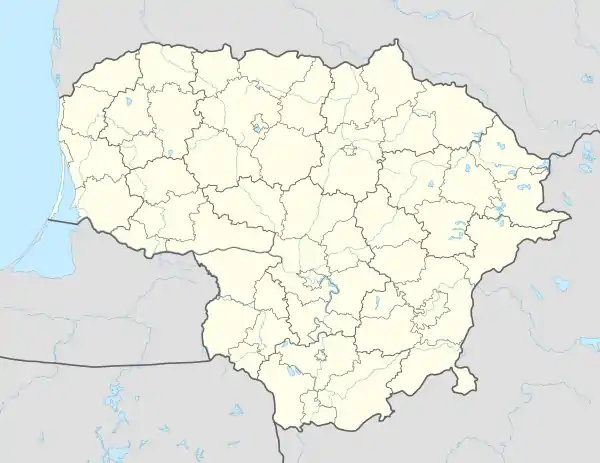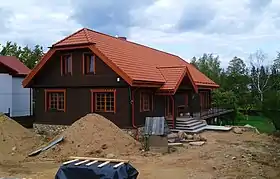Naujoji Vilnia
Naujoji Vilnia (Polish: Nowa Wilejka) is a neighborhood in eastern Vilnius, Lithuania situated along the banks of the Vilnia River. It has eldership status. According to the 2011 census, the municipality has a population of 31,933.[1]
Naujoji Vilnia | |
|---|---|
 Naujoji Vilnia as seen from surrounding hills | |
 Naujoji Vilnia Location of Naujoji Vilnia | |
| Coordinates: 54°42′N 25°25′E | |
| Country | |
| County | |
| Municipality | Vilnius city municipality |
| Area | |
| • Total | 39.3 km2 (15.2 sq mi) |
| Population (2016) | |
| • Total | 32,800 |
| • Density | 830/km2 (2,200/sq mi) |
| Time zone | UTC+2 (EET) |
| • Summer (DST) | UTC+3 (EEST) |
History


New Vileika emerged as a separate town in the second half of the 19th century when the Warsaw – Saint Petersburg Railway was built. It grew as a narrow strip along the rails. Then another major Libau–Romny Railway line connecting Vilnius with Minsk was built. Before the World War I, Naujoji Vilnia was one of the most industrialized cities in Lithuania, growing to 10,300 inhabitants in 1903, one of the largest in Lithuania at the time (comp. to Alytus with 3,445, Marijampolė with 6,777 or Panevėžys with 12,968 inhabitants in 1897). It had a number of metal and wood manufacturing factories, yeast, scythes, knives, paper and knitting mills.
In 1878, industrialists Wyszwianski and Szereszewski hailing from Berlin came to Naujoji Vilnia and established German-Russian nail factory with 90 workers. In 1882, the factory was bought by the wealthiest man in Lübeck of the time Emil Possehl. Additional 60 specialists from Styria were invited to work at the plant. Raw materials, from which scythes were produced were from Emil Possehl's steel factory in Sweden. In 1886 1 million scythes were produced. In 1900 scythes, produced in Naujoji Vilnia were demonstrated at The World's Fair in Paris. In 1905 there were 450 laborers working in the factory. Before the World War I, more than 3 million scythes were produced at the factory. The scythes and nails factory in Naujoji Vilnia was the sole largest in the World at the time.[2][3]
In 1911, Church of St. Casimir was built.
During mass deportations to Siberia in June 1941, some 30,000 deportees passed through the Naujoji Vilnia railway station. After World War II, former shops were nationalized by the Soviet authorities and converted into large factories for machine tools, agricultural equipment and other factories. In 1957 it was incorporated into Vilnius city.
In May 1991, pro-Soviet politicians associated with Yedinstvo unilaterally proclaimed the illegal establishment of the so-called Polish National-Territorial Region, projected in ethnically-mixed Vilnius Region district just outside of Vilnius, complete with its own flag, anthem, bank and the "capital" at Naujoji Vilnia. In August of the same year Lithuanian authorities cracked down on these actions as separatists in the area had supported the failed August Putsch in Moscow.
People
- Tadeusz Konwicki, Polish writer
Twin towns
Footnotes
- "Vilniaus apskritis (Vilnius county), 2011 Census". Lietuvos statistikos departamentas.
- Didžiausias pasaulyje dalgių fabrikas – tik viena Naujosios Vilnios įdomybė
- Dalgių fabrikas
References
- Simas Sužiedėlis, ed. (1970–1978). "Naujoji Vilnia". Encyclopedia Lituanica. IV. Boston, Massachusetts: Juozas Kapočius. p. 52. LCC 74-114275.
